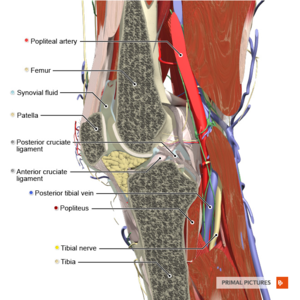Hoffa’s Test: Difference between revisions
(Added purpose, technique and evidence.) |
No edit summary |
||
| (2 intermediate revisions by one other user not shown) | |||
| Line 1: | Line 1: | ||
<div class="editorbox"> '''Original Editor '''- [[User: | <div class="editorbox"> '''Original Editor '''- [[User:Lilian Ashraf|Lilian Ashraf]]<br> | ||
'''Top Contributors''' - {{Special:Contributors/{{FULLPAGENAME}}}}</div> | '''Top Contributors''' - {{Special:Contributors/{{FULLPAGENAME}}}}</div> | ||
== Purpose<br> == | == Purpose<br> == | ||
[[File:Sagittal section of the knee joint Primal.png|thumb|Knee Joint ]] | |||
Hoffa’s test is used to clinically diagnose impingement of the infrapatellar fat pad. [[Fat Pad Syndrome|Impingement of the infrapatellar fat pad]] (Hoffa’s disease) is one of the causes of [[Anterior Knee Pain|anterior knee pain]].<ref name=":0">Kumar D, Alvand A, Beacon JP. Impingement of infrapatellar fat pad (Hoffa’s disease): results of high-portal arthroscopic resection. Arthroscopy: The Journal of Arthroscopic & Related Surgery. 2007 Nov 1;23(11):1180-6.</ref> | |||
== Technique == | |||
The knee is flexed and each fat pad is tested by applying pressure to the medial or lateral side of the [[Patellar Tendinopathy|patellar tendon]]. Then the [[knee]] is passively extended while the pressure is maintained. This maneuver forces the pad into the [[Patellofemoral Joint|patellofemoral joint]] thus exacerbating the pain.<ref>Gerbino PG. Adolescent anterior knee pain. Operative Techniques in Sports Medicine. 2006 Jul 1;14(3):203-11.</ref><ref name=":0" /> | |||
The | The test is positive for impingement if pain and discomfort is felt during the last 10 degrees of knee extension.<ref name=":1">Mr James MA, Bhatti W, ANAND MS. Infrapatellar fat pad syndrome: a review of anatomy, function, treatment and dynamics. Acta Orthopaedica Belgica. 2016;82:1-2016.</ref> | ||
{{#ev:youtube|kbu9nybRV0M}}<ref>Lenny Macrina. Fat Pad Assessment. Available from: https:https://www.youtube.com/watch?v=https://youtu.be/kbu9nybRV0M [last accessed 08/01/2022]</ref> | |||
Krumar et al suggested a modification of hoffa’s test. The knee is taken passively into hyperextension by applying pressure on the proximal tibia by one hand and holding the heel by the other hand.<ref name=":0" /> | Krumar et al suggested a modification of hoffa’s test. The knee is taken passively into hyperextension by applying pressure on the proximal [[tibia]] by one hand and holding the heel by the other hand.<ref name=":0" /> | ||
This maneuver attempts to take the knee to the last few degrees of normal hyperextension with no pressure applied directly over the infrapatellar fat pad. As Krumar et al, suggest that | This maneuver attempts to take the knee to the last few degrees of normal hyperextension with no pressure applied directly over the infrapatellar fat pad. As Krumar et al, suggest that if the infrapatellar fat pad is pathologic, impingement should occur during terminal extension without any direct pressure over the fat pad and applying pressure over the fat pad could trigger pain in the surrounding structures resulting in false positive.<ref name=":1" /> | ||
== Evidence == | == Evidence == | ||
Latest revision as of 02:48, 9 January 2022
Purpose
[edit | edit source]
Hoffa’s test is used to clinically diagnose impingement of the infrapatellar fat pad. Impingement of the infrapatellar fat pad (Hoffa’s disease) is one of the causes of anterior knee pain.[1]
Technique[edit | edit source]
The knee is flexed and each fat pad is tested by applying pressure to the medial or lateral side of the patellar tendon. Then the knee is passively extended while the pressure is maintained. This maneuver forces the pad into the patellofemoral joint thus exacerbating the pain.[2][1]
The test is positive for impingement if pain and discomfort is felt during the last 10 degrees of knee extension.[3]
Krumar et al suggested a modification of hoffa’s test. The knee is taken passively into hyperextension by applying pressure on the proximal tibia by one hand and holding the heel by the other hand.[1]
This maneuver attempts to take the knee to the last few degrees of normal hyperextension with no pressure applied directly over the infrapatellar fat pad. As Krumar et al, suggest that if the infrapatellar fat pad is pathologic, impingement should occur during terminal extension without any direct pressure over the fat pad and applying pressure over the fat pad could trigger pain in the surrounding structures resulting in false positive.[3]
Evidence[edit | edit source]
No evidence for the sensitivity or specificity of Hoffa’s test or its modification can be found.
References[edit | edit source]
- ↑ 1.0 1.1 1.2 Kumar D, Alvand A, Beacon JP. Impingement of infrapatellar fat pad (Hoffa’s disease): results of high-portal arthroscopic resection. Arthroscopy: The Journal of Arthroscopic & Related Surgery. 2007 Nov 1;23(11):1180-6.
- ↑ Gerbino PG. Adolescent anterior knee pain. Operative Techniques in Sports Medicine. 2006 Jul 1;14(3):203-11.
- ↑ 3.0 3.1 Mr James MA, Bhatti W, ANAND MS. Infrapatellar fat pad syndrome: a review of anatomy, function, treatment and dynamics. Acta Orthopaedica Belgica. 2016;82:1-2016.
- ↑ Lenny Macrina. Fat Pad Assessment. Available from: https:https://www.youtube.com/watch?v=https://youtu.be/kbu9nybRV0M [last accessed 08/01/2022]







